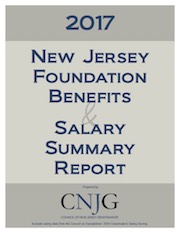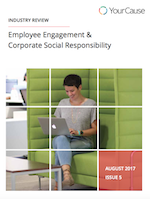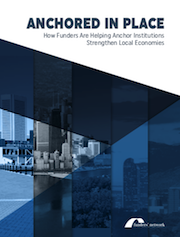Site Search
- resource provided by the Forum Network Knowledgebase.
Search Tip: Search with " " to find exact matches.
This research presents the first updated understanding of the current landscape of giving circles and similar models of collective giving or giving collaboratives in the United States in over 10 years.
Top 10 findings from a three-part study of giving circles, their impact and their relationship with their hosting organizations significantly updates our understanding of the current scope, scale and significance of giving circles and other models of collective giving in the U.S. Additionally, this study deepens our understanding of the impact of participation in giving circles on donors’ giving and civic engagement and offers actionable information related to the relationships between giving circles and their hosting organizations.

The 2017 New Jersey Foundation Benefits & Salary Report provides a valuable benchmarking resource. Developed and compiled for Council members exclusively, the report presents comprehensive benefits data specific to New Jersey's grantmaking community, alongside data from the Council on Foundations' annual salary survey.

YourCause has released their latest Industry Review on employee engagement and corporate social responsibility programs.

This report by the Funders’ Network for Smart Growth and Livable Communities examines the potential of anchor institutions hold to create lasting and sustainable change—and illustrates how funders are working with anchor institutions to create healthier, more equitable, and economically vibrant places to live and work.
Evaluators, foundations and nonprofits need to examine the “fit” of our existing evaluation approaches with the principles and values that underlie grantmaking and efforts designed to advance equity.
CNJG's Storify content from their Signature Events.
For this suite of resources, GrantCraft captured the wisdom of philanthropic leaders who have participated in multi-party advocacy collaboratives and conducted a literature scan of how foundations talk about advocacy-focused collaborative work.
The William and Flora Hewlett Foundation has had a long-standing commitment to increasing the effectiveness of grantmaking organizations, a commitment reflected in its Philanthropy Grantmaking Program. In 2015, the Foundation commissioned Harder+Company Community Research, in partnership with Edge Research, to conduct a field scan to inform its own strategies in this area as well as those of other organizations working to increase philanthropic effectiveness.
These profiles highlight the economic importance, diversity, and community impact of the charitable sector in each of the 50 states.
These resources are from CNJG's 2016 Annual Meeting & Holiday Luncheon where the topic of shifting demographics was explored.
Philanthropy and the Social Economy: Blueprint 2017 is an annual industry forecast about the ways we use private resources for public benefit.
The William Penn Foundation commissioned a study to move beyond the anecdotal and see if and how students benefited from being involved in some of its grantee arts programs. The research by WolfBrown, working with Johns Hopkins University, showed that participating in the arts help students develop traits that contribute to later success in life. Younger students especially showed measurable growth in characteristics like tolerance for other points of view, an understanding that hard work can develop their knowledge and abilities, and their motivation to achieve.
The Funders Collaborative was an innovative partnership supported by 14 local and national foundations. The collaborative supplemented the programs and grantmaking of its member foundations by working with community organizations, the business sector and public agencies to encourage collaboration, planning and investment “beyond the rail.”
State and National disaster relief organizations and resources for funders and individuals.
Based sardonically on Masterpiece Theatre, Washington Regional Association of Grantmakers’s Structural Racism Theater introduces the viewer to concrete examples of structural racism and implicit bias. It’s edgy, dryly humorous, “shareable,” and an incredibly different direction for WRAG. The first episode, "The Pernicious Compromise," focuses on the timely topic of the Electoral College and its connection to the Three-Fifths Compromise.
Based sardonically on Masterpiece Theatre, Structural Racism Theater introduces the viewer to concrete examples of structural racism and implicit bias in an edgy, social media-friendly way. In "Darkness in Emerald City," we look at the relationship between implicit bias and institutional racism.
Research shows that one of the greatest impediments to a prosperous future for all of Michigan's people is unequal access to resources. To help foundation leaders and their boards begin essential conversations about marginalized populations and determine the extent to which their organization's culture and grantmaking practices are aligned with a commitment to expanding opportunity in the communities they serve, CMF developed this discussion guide and self-assessment.
Foundation leaders have a unique opportunity to serve as powerful champions of their missions. Partnering with your grantees can amplify your impact. The following guide is designed to help you start having an honest conversation in the boardroom; a conversation about your foundation’s goals, approach, and, most importantly, vision for the future.
Daniel Kemmis explores the sometimes-fraught relationship between philanthropy and democracy in this updated report. Beginning with a wide-ranging stroll through the shared history of philanthropy and democracy, Kemmis examines the current post-Citizens United landscape and asks whether philanthropy can and should do more to strengthen the infrastructure and practices of democracy.
